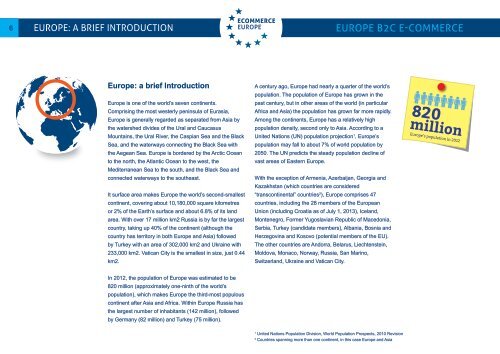Create successful ePaper yourself
Turn your PDF publications into a flip-book with our unique Google optimized e-Paper software.
6<br />
EUROPE: A BRIEF INTRODUCTION EUROPE <strong>B2C</strong> E-COMMERCE<br />
<strong>Europe</strong>: a brief Introduction<br />
<strong>Europe</strong> is one of the world’s seven continents.<br />
Comprising the most westerly peninsula of Eurasia,<br />
<strong>Europe</strong> is generally regarded as separated from Asia by<br />
the watershed divides of the Ural and Caucasus<br />
Mountains, the Ural River, the Caspian Sea and the Black<br />
Sea, and the waterways connecting the Black Sea with<br />
the Aegean Sea. <strong>Europe</strong> is bordered by the Arctic Ocean<br />
to the north, the Atlantic Ocean to the west, the<br />
Mediterranean Sea to the south, and the Black Sea and<br />
connected waterways to the southeast.<br />
It surface area makes <strong>Europe</strong> the world’s second-smallest<br />
continent, covering about 10,180,000 square kilometres<br />
or 2% of the Earth’s surface and about 6.8% of its land<br />
area. With over 17 million km2 Russia is by far the largest<br />
country, taking up 40% of the continent (although the<br />
country has territory in both <strong>Europe</strong> and Asia) followed<br />
by Turkey with an area of 302,000 km2 and Ukraine with<br />
233,000 km2. Vatican City is the smallest in size, just 0.44<br />
km2.<br />
In 2012, the population of <strong>Europe</strong> was estimated to be<br />
820 million (approximately one-ninth of the world’s<br />
population), which makes <strong>Europe</strong> the third-most populous<br />
continent after Asia and Africa. Within <strong>Europe</strong> Russia has<br />
the largest number of inhabitants (142 million), followed<br />
by Germany (82 million) and Turkey (75 million).<br />
A century ago, <strong>Europe</strong> had nearly a quarter of the world’s<br />
population. The population of <strong>Europe</strong> has grown in the<br />
past century, but in other areas of the world (in particular<br />
Africa and Asia) the population has grown far more rapidly.<br />
Among the continents, <strong>Europe</strong> has a relatively high<br />
population density, second only to Asia. According to a<br />
United Nations (UN) population projection 1 , <strong>Europe</strong>’s<br />
population may fall to about 7% of world population by<br />
2050. The UN predicts the steady population decline of<br />
vast areas of Eastern <strong>Europe</strong>.<br />
With the exception of Armenia, Azerbaijan, Georgia and<br />
Kazakhstan (which countries are considered<br />
“transcontinental” countries 2 ), <strong>Europe</strong> comprises 47<br />
countries, including the 28 members of the <strong>Europe</strong>an<br />
Union (including Croatia as of July 1, <strong>2013</strong>), Iceland,<br />
Montenegro, Former Yugoslavian Republic of Macedonia,<br />
Serbia, Turkey (candidate members), Albania, Bosnia and<br />
Herzegovina and Kosovo (potential members of the EU).<br />
The other countries are Andorra, Belarus, Liechtenstein,<br />
Moldova, Monaco, Norway, Russia, San Marino,<br />
Switzerland, Ukraine and Vatican City.<br />
1 United Nations Population Division, World Population Prospects, 2010 Revision<br />
2 Countries spanning more than one continent, in this case <strong>Europe</strong> and Asia<br />
820<br />
million<br />
<strong>Europe</strong>’s population in 2012


